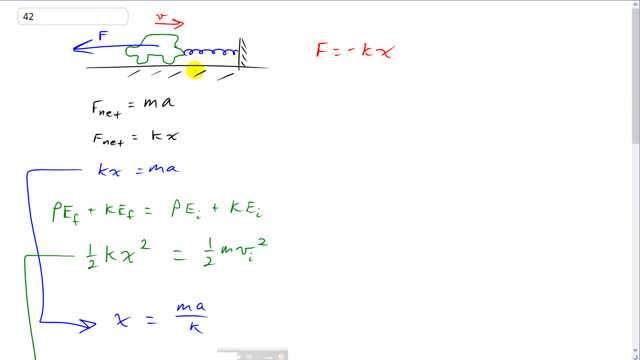
What should be the spring constant of a spring designed to bring a 1200-kg car to rest from a speed of 95 km/h so that the occupants undergo a maximum acceleration of 4.0 g?

In order to watch this solution you need to have a subscription.
This is Giancoli Answers with Mr. Dychko. So the car is approaching this spring at 95 kilometers an hour and we are told that the occupants can experience an acceleration, no more than 4.0 g's. And that maximum acceleration will occur when they experience the maximum spring force, which will happen when the spring is fully compressed because the spring obeys Hooke's law; the force exerted by the spring is the spring constant times the amount of compression. So, when we are considering our initial and final points here in this conservation of energy formula, we'll be considering the final point to be when the spring is fully compressed and there's no kinetic energy, in other words. And, initially, we have not touching the spring and so there's no potential energy initially. And so we have one-half spring constant times compression squared equals one-half mass times initial velocity squared, before it hits the spring. So, that's conservation of energy business but then we are also told about this constraint on the acceleration. So, the net force on this car is gonna be the spring force; that's the only force that's gonna be horizontal and so the spring force will equal mass times acceleration. Spring force is also kx because it's Hooke's law; nevermind the negative sign, that's just direction, I mean, the force and the acceleration are in the same direction so they have the same signs. So, we can say that kx equals ma because both are them are equal to the net force. And when we look at this conservation of energy formula, we need to solve for k. So, we need to get rid of this variable x, which we don't know and we can use this equation to make a substitution. So, we'll solve this equation in blue from the net force for x; x equals ma over k when you divide both sides by k. And then we'll substitute that in to the energy formula and we'll do that right here. We have ma over k in place of x and we do a bit of algebra to solve for k. So, we have mass squared times acceleration squared divided by k squared but there's one k here so that makes only divide by k to the power of 1 and all over 2. And that equals one-half mv i squared. Divide both sides by m, and you end up with this line and also multiply both sides by 2; we are just cleaning things up here, step-by-step; get rid of the denominator 2, get rid of one of the m's, and we have m a squared over k equals v initial squared. And we'll solve this for k by multiplying both sides by k over v initial squared. And then, we have k on the right hand side, which we'll put on the left since we'll flip the sides around. So, we have k equals m a squared over v initial squared. And substituting numbers, we have 1200 kilograms times 4 g's times 9.8 meters per second squared per g and square that result of that product divided by the speed converted into meters per second by dividing by 3.6 or multiplying by 1 hour for every 3600 seconds and times by a 1000 meters per kilometer and square that resulting speed, in meters per second, and we get 2600 newtons per meter should be the spring constant, rounded to two significant figures.
I found the distance using d = vf^2-vi^2/2a and I got 8.9 m. When I substitute that into the 1/2kx^2=1/2mv^2 equation I get a k equal to 10500 N/m. What am I doing wrong?
Hi tmesser, good question. The tricky thing here is that acceleration is not constant. All of the kinematics formulas, like $d = \dfrac{v_f^2-v_i^2}{2a}$, assume acceleration is constant, so it can't be used in this question. Only conservation of energy can be used, plus the Hook's law for a spring, and $F_{net}=ma$, all three of which don't assume constant acceleration. The acceleration isn't constant since the force applied by the spring on the car changes depending on how much the spring is compressed. In the beginning the spring pushes only lightly, so the car's deceleration is small, but then as the spring is compressed it pushes harder on the car thereby increasing the deceleration.
Hope that helps,
Mr. Dychko
How do you get the units N/m? I’m getting kg/s^2 which is not a thing I’m familiar with.
How do you know to use 9.8m/s^2 per g? Is that just gravity when dealing with g’s?
Hi fortunado09, N/m is another way of saying $\textrm{kg / s}^2$. Using one or the other is just a matter of personal preference, and I prefer $\textrm{ N/m}$ since I think it better conveys the idea of a spring constant being the number of Newtons of force the spring will exert for each meter that it's compressed. If you expand the Newtons in $\textrm{ N / m}$ to base units, you'll find am "m" cancels, leaving you with your correct alternative units of $\textrm{ kg / s}^s$.
Cheers,
Mr. Dychko
Ah, and yes, "g's" are assumed to be the acceleration of gravity near the surface of Earth, so it can always be substituted with $9.8 \textrm{ m / s}^s$ unless the question explicitly says something else (such as "on Mars" or "10 000 m above the Earth").